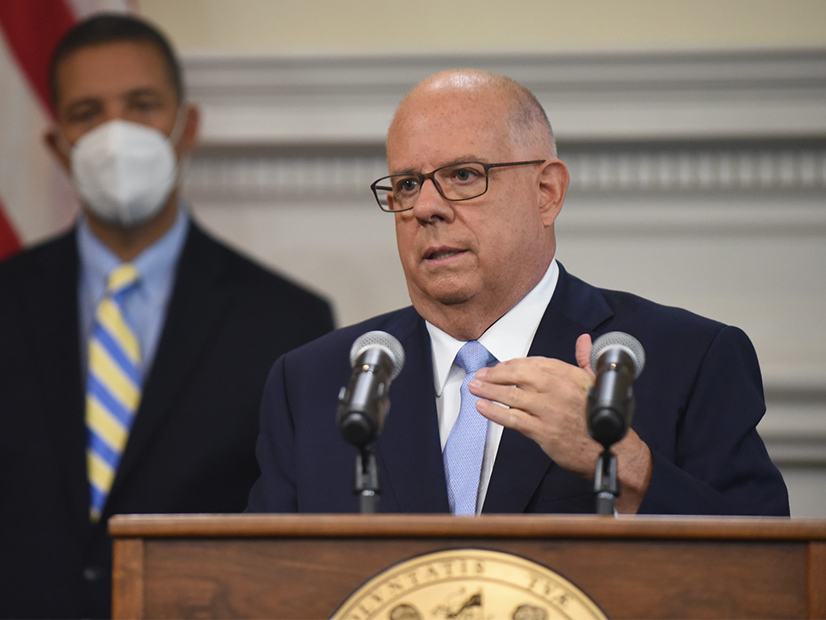A legislative showdown is brewing over Maryland Senate Bill 528, the Climate Solutions Now Act, which would require the state to cut its greenhouse gas emissions to net zero by 2045, convert its vehicle fleet to electric and establish distribution system planning to help achieve these and other clean energy goals.
Gov. Larry Hogan (R) is expected to veto the bill, and Democrats in the General Assembly are expected to override that veto, allowing the bill to become law before the legislative session ends on April 11.
The main question now is how close to the wire the likely veto and override will occur. In a statement released March 10, Hogan slammed the bill as a “reckless and controversial energy tax.” Senate Democrats, however, pushed the bill through a final 32-15 vote on Thursday, with substantial amendments from the House of Delegates, to get it to Hogan’s desk on Friday.
The vote in the House was similarly veto-proof, 95-42. Under state law, Hogan has six days, not counting Sunday, to sign or veto the bill, or let it become law without his signature. If he holds the anticipated veto until the sixth day, April 7, Democrats will have a tight window for the override.
In addition to the 2045 net-zero target, the bill’s key provisions include:
- an increase in the state’s interim target for emissions reductions, from 40% in 2030 to 60% in 2031.
- the establishment of a Climate Catalytic Capital Fund that will be used to start a green bond program and help finance and leverage private investment for a range of emission-reduction and clean energy programs. Initial allocations for the fund would be $5 million a year for 2024 to 2026.
- a $50 million electric school bus pilot program that will allow utilities to test out the use of vehicle-to-grid technologies at times electric buses in the program are not in use.
- a steady phase-in of EVs in the state’s passenger car fleet, with 100% of all new purchases electric or hybrid by 2028 and 100% of all other light-duty vehicles electric by 2033.
The House Amendments
The school bus pilot and the distribution planning requirements were part of the 50-page package of amendments passed in the House on March 29. Under the new planning provisions, beginning in December 2024, the Public Service Commission would have to submit a yearly report to the General Assembly on the “current status of electric distribution system evolution.”
As listed in the bill, specific goals of distribution planning would include the incorporation of a range of distributed energy resources, such as electric vehicles, energy storage, demand response and non-wires alternatives.
But the House amendments also softened or cut some of the bill’s core initiatives.
Cut entirely from the bill were net-zero school provisions requiring that, from 2023 to 2033, at least one new school in each school district be built to net-zero standards.
The Senate’s provisions on building performance standards were another casualty. They would have required that new or renovation projects built with at least 25% state funding meet high-performance building standards developed by the Maryland Green Building Council. Emission-reduction targets for large commercial buildings and multifamily dwellings were also cut, from 50% to 20% in 2030, and a net-zero target for 2035 was completely eliminated.
The House amendments also rebranded the Maryland Climate Justice Corps in the original Senate version as the Chesapeake Conservation Corps. The goal in both cases is to provide education and job training programs to help develop “green career ladders” for youth and young adults, but with a shift in focus from environmental justice to environmental conservation.
For example, while a primary purpose of the Climate Justice Corp was to “promote climate justice and assist the state in achieving its greenhouse gas emissions-reduction targets,” the corresponding goal of the Conservation Corps is to “promote, preserve, protect and sustain the environment.”
Reactions
Tweeting out an announcement of final passage of the bill, Sen. Paul Pinsky (D), SB 528’s chief sponsor, called it “a victory,” pointing to the 60% emission-reduction target for 2031 and the 20% target for cutting building emissions.
“It’s no question that climate change presents an existential threat,” House Speaker Adrienne A. Jones (D) tweeted on Friday. “We passed Climate Solutions Now to have more aggressive greenhouse gas-reduction goals and reduce our carbon footprint faster.”
Environmental groups also stayed focused on the positive impact the bill will have.
“We owe it to future generations of Marylanders to address the root causes of the stronger storms, rising sea levels and higher temperatures that threaten their quality of life, and this bill is a strong step toward doing so,” Josh Kurtz, executive director of the Chesapeake Bay Foundation, said in a statement released after the House passed the bill.
“The Climate Solutions Now Act takes concrete steps that are good for our economy and all our communities,” said Kim Coble, executive director of the Maryland League of Conservation Voters. The bill will, she said, “put Maryland on the path to lead the nation once again in addressing climate change in a responsible, achievable and equitable manner.”
Beyond his initial statement in March, Hogan has made no subsequent comments on the bill.



